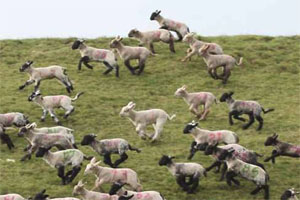Lamb 'get up and go'
Published on 23 June 2011 in Food, health and wellbeing
Research by SRUC (formerly SAC) has led to the development of a number of genetic tools to improve lamb survival. Behavioural traits that are important for lamb survival, such as lamb ‘get up and go’, can now by measured quickly and simply by farmers, using scores based on lamb behaviour. These scores are under genetic control, so farmers will now have the option to select rams for better lamb survivability, based on improved lamb vigour.

Key Challenges
Lamb mortality averages 15% of lambs born across all sheep producing countries, although the mortality on some farms may be much higher. Ewe management can improve lamb survival but, despite much research in this area, lamb mortality has proved to be a difficult figure to reduce. This constrains profitable, sustainable and high welfare sheep production. New approaches to the problem, such as those developed by SRUC, are needed to achieve better survival and improve both farm livelihoods and sheep welfare.
Key Benefits
In the UK an average loss of 15% of lambs before weaning equates to about 2.7 million lambs being lost each year. This means lost revenue to the producer, at a potential annual cost of £160 million pounds to the UK sheep industry. It also constrains the ability of marginal areas, in particular, to produce food. In addition, reproductive inefficiency, where ewes fail to produce and rear lambs, increases the carbon footprint of sheep production. This means a greater number of animals are needed to produce the same outputs. An increase in lamb survival of 3% a year would increase productivity by nearly half a million lambs. This would add £25 million to the economy and reduce by more than 300,000 the number of ewes required to produce an equivalent quantity of lamb.
At the farm level, labour directed towards keeping lambs alive can account for up to 28 person hours per 100 lambs. Farms face considerable costs to buy in labour to meet these needs. Using on-farm labour to meet these requirements takes up time that might be spent more profitably elsewhere.
An increase in lamb survival of 3% a year would increase productivity by nearly a million lambs, adding £36 million to the economy and reducing by more than half a million the number of ewes required to produce an equivalent quantity of lamb.
In addition to the financial and environmental benefits of improving lamb survival, the loss of so many lambs is a cause for welfare concern. Improving animal welfare is believed to be a societal benefit. The UK has an often-expressed concern for animal welfare, ranking it as the most important food-related concern in 2010. Any action that improves animal welfare will therefore have an important benefit to society.
The support from Scottish Government for this area of research over the last 17 years has secured an excellent foundation of scientific research. This has provided leverage to obtain a range of new funding sources. These have included BBSRC, BioSciences KTN and the support of commercial sheep breeders. The introduction of the new Scottish Government research Programme 2011-16 will bring new dimensions of research to the work by making these tools and knowledge more widely available to encourage greater uptake and participation by sheep producers. This will broaden the scope of this research to bring about a substantial increase in the survival of lambs in the UK.


Comments or Questions
Related Websites
Our Partners
This work was funded by the Scottish Government and more recently with BioSciences KTN, BBSRC and Suffolk Sheep Society, in collaboration with BioSS.
Find Out More
For more information contact Dr Cathy Dwyer, Cathy.Dwyer@sruc.ac.ukAuthor
Dr Cathy Dwyer Cathy.Dwyer@sruc.ac.uk





